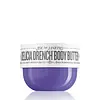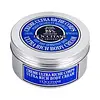What's inside
What's inside
 Key Ingredients
Key Ingredients

 Benefits
Benefits

 Concerns
Concerns

 Ingredients Side-by-side
Ingredients Side-by-side

Water
Skin ConditioningButyrospermum Parkii Butter
Skin ConditioningCocos Nucifera Oil
MaskingEthylhexyl Palmitate
EmollientParfum
MaskingMethyl Glucose Sesquistearate
EmollientGlyceryl Stearate Se
EmulsifyingLauryl Laurate
Skin ConditioningGlycerin
HumectantMyristyl Myristate
EmollientHydrolyzed Sodium Hyaluronate
Skin ConditioningLactobacillus/Hibiscus Sabdariffa Flower Ferment Filtrate
Skin ConditioningCopaifera Officinalis Resin
MaskingPassiflora Edulis Seed Oil
EmollientPlatonia Insignis Seed Butter
EmollientTheobroma Grandiflorum Seed Butter
Skin ConditioningSqualane
EmollientTocopherol
AntioxidantBixa Orellana Seed Extract
MaskingCetearyl Alcohol
EmollientBehenyl Alcohol
EmollientCaprylic/Capric Triglyceride
MaskingPhenyl Trimethicone
Skin ConditioningMaltodextrin
AbsorbentCetearyl Olivate
Sorbitan Olivate
EmulsifyingSodium Stearoyl Glutamate
CleansingPotassium Cetyl Phosphate
EmulsifyingSodium Gluconate
Skin ConditioningEthylhexylglycerin
Skin ConditioningPhenoxyethanol
PreservativeButylene Glycol
HumectantCarbomer
Emulsion StabilisingPotassium Hydroxide
BufferingSodium Hydroxide
BufferingCI 75120
Cosmetic ColorantAlpha-Isomethyl Ionone
PerfumingWater, Butyrospermum Parkii Butter, Cocos Nucifera Oil, Ethylhexyl Palmitate, Parfum, Methyl Glucose Sesquistearate, Glyceryl Stearate Se, Lauryl Laurate, Glycerin, Myristyl Myristate, Hydrolyzed Sodium Hyaluronate, Lactobacillus/Hibiscus Sabdariffa Flower Ferment Filtrate, Copaifera Officinalis Resin, Passiflora Edulis Seed Oil, Platonia Insignis Seed Butter, Theobroma Grandiflorum Seed Butter, Squalane, Tocopherol, Bixa Orellana Seed Extract, Cetearyl Alcohol, Behenyl Alcohol, Caprylic/Capric Triglyceride, Phenyl Trimethicone, Maltodextrin, Cetearyl Olivate, Sorbitan Olivate, Sodium Stearoyl Glutamate, Potassium Cetyl Phosphate, Sodium Gluconate, Ethylhexylglycerin, Phenoxyethanol, Butylene Glycol, Carbomer, Potassium Hydroxide, Sodium Hydroxide, CI 75120, Alpha-Isomethyl Ionone
Water
Skin ConditioningButyrospermum Parkii Butter
Skin ConditioningDicaprylyl Carbonate
EmollientGlycerin
HumectantTapioca Starch
Pentylene Glycol
Skin ConditioningCetearyl Alcohol
EmollientGlyceryl Stearate
EmollientPEG-100 Stearate
Dimethicone
EmollientHelianthus Annuus Seed Oil
EmollientCeteareth-33
CleansingHydroxyethyl Acrylate/Sodium Acryloyldimethyl Taurate Copolymer
Emulsion StabilisingSodium PCA
HumectantGlyceryl Caprylate
EmollientTocopherol
AntioxidantXanthan Gum
EmulsifyingPolysorbate 60
EmulsifyingSorbitan Isostearate
EmulsifyingBeta-Glucan
Skin ConditioningCaprylyl Glycol
EmollientParfum
MaskingWater, Butyrospermum Parkii Butter, Dicaprylyl Carbonate, Glycerin, Tapioca Starch, Pentylene Glycol, Cetearyl Alcohol, Glyceryl Stearate, PEG-100 Stearate, Dimethicone, Helianthus Annuus Seed Oil, Ceteareth-33, Hydroxyethyl Acrylate/Sodium Acryloyldimethyl Taurate Copolymer, Sodium PCA, Glyceryl Caprylate, Tocopherol, Xanthan Gum, Polysorbate 60, Sorbitan Isostearate, Beta-Glucan, Caprylyl Glycol, Parfum
 Reviews
Reviews

Alternatives
Ingredients Explained
These ingredients are found in both products.
Ingredients higher up in an ingredient list are typically present in a larger amount.
This ingredient is also known as shea butter. It is an effective skin hydrator and emollient.
Emollients help soothe and soften your skin. It does this by creating a protective film on your skin. This barrier helps trap moisture and keeps your skin hydrated. Emollients may be effective at treating dry or itchy skin.
Shea butter is rich in antioxidants. Antioxidants help fight free-radicals, or molecules that may harm the body. It is also full of fatty acids including stearic acid and linoleic acid. These acids help replenish the skin and keep skin moisturized.
While Shea Butter has an SPF rating of about 3-4, it is not a sunscreen replacement.
Shea butter may not be fungal acne safe. We recommend speaking with a professional if you have any concerns.
Learn more about Butyrospermum Parkii ButterCetearyl alcohol is a mixture of two fatty alcohols: cetyl alcohol and stearyl alcohol. It is mainly used as an emulsifier. Emulsifiers help prevent the separation of oils and products. Due to its composition, it can also be used to thicken a product or help create foam.
Cetearyl alcohol is an emollient. Emollients help soothe and hydrate the skin by trapping moisture.
Studies show Cetearyl alcohol is non-toxic and non-irritating. The FDA allows products labeled "alcohol-free" to have fatty alcohols.
This ingredient is usually derived from plant oils such as palm, vegetable, or coconut oils. There is debate on whether this ingredient will cause acne.
Due to the fatty acid base, this ingredient may not be Malassezia folliculitis safe.
Learn more about Cetearyl AlcoholGlycerin is already naturally found in your skin. It helps moisturize and protect your skin.
A study from 2016 found glycerin to be more effective as a humectant than AHAs and hyaluronic acid.
As a humectant, it helps the skin stay hydrated by pulling moisture to your skin. The low molecular weight of glycerin allows it to pull moisture into the deeper layers of your skin.
Hydrated skin improves your skin barrier; Your skin barrier helps protect against irritants and bacteria.
Glycerin has also been found to have antimicrobial and antiviral properties. Due to these properties, glycerin is often used in wound and burn treatments.
In cosmetics, glycerin is usually derived from plants such as soybean or palm. However, it can also be sourced from animals, such as tallow or animal fat.
This ingredient is organic, colorless, odorless, and non-toxic.
Glycerin is the name for this ingredient in American English. British English uses Glycerol/Glycerine.
Learn more about GlycerinParfum is a catch-all term for an ingredient or more that is used to give a scent to products.
Also called "fragrance", this ingredient can be a blend of hundreds of chemicals or plant oils. This means every product with "fragrance" or "parfum" in the ingredients list is a different mixture.
For instance, Habanolide is a proprietary trade name for a specific aroma chemical. When used as a fragrance ingredient in cosmetics, most aroma chemicals fall under the broad labeling category of “FRAGRANCE” or “PARFUM” according to EU and US regulations.
The term 'parfum' or 'fragrance' is not regulated in many countries. In many cases, it is up to the brand to define this term.
For instance, many brands choose to label themselves as "fragrance-free" because they are not using synthetic fragrances. However, their products may still contain ingredients such as essential oils that are considered a fragrance by INCI standards.
One example is Calendula flower extract. Calendula is an essential oil that still imparts a scent or 'fragrance'.
Depending on the blend, the ingredients in the mixture can cause allergies and sensitivities on the skin. Some ingredients that are known EU allergens include linalool and citronellol.
Parfum can also be used to mask or cover an unpleasant scent.
The bottom line is: not all fragrances/parfum/ingredients are created equally. If you are worried about fragrances, we recommend taking a closer look at an ingredient. And of course, we always recommend speaking with a professional.
Learn more about ParfumTocopherol (also known as Vitamin E) is a common antioxidant used to help protect the skin from free-radicals and strengthen the skin barrier. It's also fat soluble - this means our skin is great at absorbing it.
Vitamin E also helps keep your natural skin lipids healthy. Your lipid skin barrier naturally consists of lipids, ceramides, and fatty acids. Vitamin E offers extra protection for your skin’s lipid barrier, keeping your skin healthy and nourished.
Another benefit is a bit of UV protection. Vitamin E helps reduce the damage caused by UVB rays. (It should not replace your sunscreen). Combining it with Vitamin C can decrease sunburned cells and hyperpigmentation after UV exposure.
You might have noticed Vitamin E + C often paired together. This is because it is great at stabilizing Vitamin C. Using the two together helps increase the effectiveness of both ingredients.
There are often claims that Vitamin E can reduce/prevent scarring, but these claims haven't been confirmed by scientific research.
Learn more about TocopherolWater. It's the most common cosmetic ingredient of all. You'll usually see it at the top of ingredient lists, meaning that it makes up the largest part of the product.
So why is it so popular? Water most often acts as a solvent - this means that it helps dissolve other ingredients into the formulation.
You'll also recognize water as that liquid we all need to stay alive. If you see this, drink a glass of water. Stay hydrated!
Learn more about Water